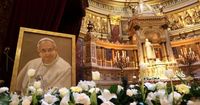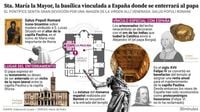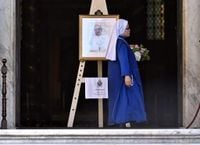On April 26, 2025, thousands of faithful gathered around the Basilica of Santa María la Mayor in Rome to bid farewell to Pope Francis, who passed away on April 21 at the age of 88. This significant event marks not just a farewell to a beloved leader but also a pivotal moment in the history of the Catholic Church, as it is the first time in over a century that a pope will be buried outside the Vatican.
Pope Francis, known for his innovative approach and deep connection with the people, chose to be laid to rest in the Basilica of Santa María la Mayor, a historic church with origins dating back to the fourth century. This basilica, the largest of the eighty Marian churches in Rome, was built by Pope Sixto III in 432 AD on the Esquiline Hill. The site is steeped in legend, as it is believed to be where the Virgin Mary appeared in dreams to Pope Liberio, leading to the miraculous snowfall that is commemorated every August 5 with a rain of white petals from the basilica's ceiling.
The decision to be buried in Santa María la Mayor instead of the traditional Vatican grottos signifies a break from a long-standing custom. Since the burial of Pope Leo XIII in the Archbasilica of St. John Lateran in 1903, all popes have been interred within the confines of the Vatican, primarily in the Vatican Grottos. The choice of Santa María la Mayor reflects Pope Francis's unique approach to leadership and his desire to remain close to the people he served.
As the funeral procession approached the basilica, the atmosphere was charged with emotion. Carol Díaz, a young Catholic from Colombia, arrived at 2 AM local time to witness the pope's coffin being brought to the basilica. She expressed her feelings, saying, "He was very close to the youth; we saw him more as a friend." Many attendees, including faithful from Mexico, Bolivia, and Peru, echoed similar sentiments, highlighting the pope's connection with the youth and the poor.
Among the crowd was Mattia Costantini, a 16-year-old from Italy, who traveled to Rome to attend the Jubilee of Youth, coinciding with the pope's funeral. He stated, "I wanted to be here at this important moment for the Church. Francis was an example, a man of hope." His words resonate with the many young people who looked up to Pope Francis for his approachable nature and progressive views.
The pope's burial will take place in a simple tomb made of marble from Liguria, the region where some of his maternal ancestors hailed. This choice aligns with his humble nature, as he often emphasized the importance of simplicity and humility throughout his papacy. The coffin is expected to arrive at the basilica around 1 PM local time, following a solemn procession through the streets of Rome.
Santa María la Mayor holds not just religious significance but also cultural ties to Spain and Latin America, regions where Pope Francis was particularly beloved. The basilica has a rich history, having been associated with Spanish royalty since the 16th century. Each year, a solemn mass is celebrated there in memory of the kings of Spain, underlining the deep-rooted connections between the Spanish monarchy and the Catholic Church.
Furthermore, the basilica is home to several significant relics, including the icon of Salus Populi Romani, which was particularly dear to Pope Francis. He frequently visited the basilica before and after his international trips to pray before this revered icon. His deep devotion to the Virgin Mary was a hallmark of his papacy, and his choice of burial place is a testament to that bond.
The ceremony is expected to draw dignitaries and representatives from around the world, showcasing the pope's global influence. As the crowd gathers, the atmosphere is one of reverence and reflection, as people remember a leader who challenged norms and inspired millions through his messages of compassion, humility, and social justice.
In the days leading up to the funeral, many pilgrims and tourists flocked to the basilica to pay their respects. The annual Miracle of the Snow celebration, which commemorates the miraculous snowfall that led to the basilica's construction, will take on a new meaning this year as it coincides with the pope's burial. This event, traditionally marked by the release of white petals from the basilica's ceiling, symbolizes purity and the enduring legacy of the Virgin Mary.
As the world watches, the funeral of Pope Francis at Santa María la Mayor serves as a poignant reminder of his contributions to the Church and the profound impact he had on the lives of many. His innovative spirit and commitment to the marginalized will continue to inspire future generations.
Ultimately, Pope Francis's choice of burial site embodies his desire to remain connected to the people he served. His legacy, marked by a commitment to social justice, compassion, and humility, will resonate within the walls of the Basilica of Santa María la Mayor for years to come, as pilgrims and visitors continue to honor his memory.






